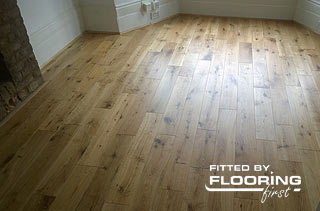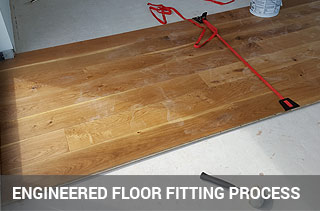Solid Wood vs Engineered Wood vs Parquet Flooring: Pros & Cons Explained
With the wide variety of wood flooring options available today, choosing the right type for your home can be a challenging task. Each option offers unique advantages and potential drawbacks, depending on your needs, budget, and design preferences. Solid wood flooring is renowned for its strength, durability, and timeless appeal. However, it often comes with a higher price tag and specific installation requirements.
provides a more cost-effective solution. It’s designed to handle subfloor irregularities with the use of underlay, reducing the need for extensive subfloor preparation before installation. Parquet flooring is another attractive choice, consisting of small wooden blocks arranged in various geometric patterns. This allows homeowners to create a stunning design feature, giving the floor a distinctive and elegant character.
In this guide, we'll explore the pros and cons of solid wood, engineered wood, and parquet flooring, helping you make an informed decision for your next flooring project.

Parquet Flooring: Timeless Elegance & Design Versatility
Parquet flooring is a sophisticated wood flooring option known for its intricate patterns and geometric designs. Crafted from real wood blocks arranged in classic styles like herringbone or chevron, parquet offers a unique blend of historical charm and contemporary elegance. Its ability to showcase natural wood grain while enhancing property value makes it a standout choice for both residential and commercial interiors.
For more details on installation methods, visit our page on Parquet Floor Installation.
Pros of Parquet Flooring
- Aesthetic Appeal: Creates a visually stunning effect with mosaic patterns that serve as a focal point in any room.
- Design Versatility: Offers a wide range of patterns, colours, and textures, from classic herringbone to intricate custom designs.
- Timeless Elegance: Complements both traditional and modern interiors with its refined look.
- Durability: Made from high-quality wood, it can withstand heavy foot traffic and be sanded and refinished multiple times.
- Increased Property Value: Adds a high-end, desirable feature that enhances the resale value of your home.
- Improved Acoustics: Dense construction helps reduce noise and improves room acoustics.
Cons of Parquet Flooring
- Complex Maintenance: Intricate patterns require more time and effort to clean and maintain.
- Sanding Difficulties: Varied grain directions make sanding challenging and require experienced professionals to avoid damage.
- Professional Renovation Required: Sanding and refinishing parquet floors should be done by experts to maintain their appearance and integrity.
- Subfloor Preparation: Requires a well-prepared subfloor and possibly additional underlayment to ensure pattern accuracy and durability.
- Higher Installation Costs: Precision fitting and alignment increase installation time and labour costs compared to simpler flooring types.

Solid Wood Flooring: Classic Durability & Natural Beauty
Solid wood flooring is a timeless choice, crafted from a single piece of timber. Known for its rich grain patterns and warm aesthetics, it brings enduring elegance to any interior. Thanks to its substantial thickness, solid wood floors can be sanded and refinished multiple times, making them a long-lasting and valuable investment.
Ideal for traditional and high-end settings, solid wood floorboards offer unmatched durability and a high-quality finish that enhances both the beauty and market value of your home.
Pros of Solid Wood Flooring
- Variety of Wood Species: Available in numerous species, colours, grains, and textures to match any interior design.
- Customisation Options: Floorboards come in various sizes and can be treated or finished to achieve your desired look.
- Natural Beauty: Renowned for its authentic appearance, adding warmth, elegance, and luxury to any space.
- Durability and Longevity: With proper care, solid wood floors can last for a century or more.
- Re-Sanding and Refinishing: Can be sanded and refinished up to six times, extending lifespan and restoring appearance.
- Enhanced Property Value: Boosts home value thanks to its classic appeal and long-term durability.
- Timeless Elegance: Complements both traditional and contemporary design styles.
Cons of Solid Wood Flooring
- Prone to Water Damage: Not recommended for moisture-prone areas like bathrooms, basements, or kitchens.
- Humidity Sensitivity: Expands and contracts with humidity changes, requiring careful installation over suitable subfloors.
- Limited Installation Options: Typically requires nailing or gluing to a level subfloor, which can increase preparation costs.
- Incompatibility with Underfloor Heating: Not suitable for homes with underfloor heating systems due to temperature sensitivity.

Engineered Wood Flooring: Versatility & Modern Durability
Engineered wood flooring combines the natural beauty of real wood with a multi-layered construction designed for enhanced stability and resilience. Featuring a top layer of hardwood veneer over layers of plywood or high-density fiberboard, engineered wood offers superior resistance to moisture and temperature fluctuations.
Available in a wide variety of wood species and finishes, engineered flooring is versatile and suitable for various installation methods. Its design makes it an excellent choice for challenging environments, including concrete subfloors and homes with underfloor heating systems.
For more installation information, visit our Engineered Wood Floor Installation services page.
Pros of Engineered Wood Flooring
- Moisture and Temperature Resistance: Multi-layered structure minimises warping, cupping, and movement due to humidity and temperature changes.
- Versatile Installation Methods: Can be nailed, glued, or floated, making it suitable for a variety of subfloors, including uneven surfaces.
- Suitable for Moisture-Prone Areas: Ideal for bathrooms, basements, and kitchens where solid wood is not recommended.
- Enhanced Installation Options: Compatible with underlays for added soundproofing and thermal insulation benefits.
- Compatibility with Concrete Subfloors: Performs well when installed over concrete, offering flexibility in modern building designs.
Cons of Engineered Wood Flooring
- Limited Sanding Opportunities: The thinner top veneer layer (lamella) allows for fewer sanding and refinishing cycles, typically up to 3 times.
- Design Variety: While diverse, engineered wood may not match the extensive customisation options available with solid wood in terms of species and grain patterns.
- Top Layer Thickness: The durability and refinishing potential depend on the lamella thickness, which may be less robust compared to solid wood floorboards.
Comparison Table: Solid Wood vs Engineered Wood vs Parquet Flooring
| Feature |
Solid Wood Flooring |
Engineered Wood Flooring |
Parquet Flooring |
| Material Structure |
One solid piece of timber throughout |
Top hardwood veneer layer over plywood or HDF core |
Solid wood blocks arranged in geometric patterns |
| Durability & Lifespan |
Highly durable, can last 100+ years with proper care |
Durable with a 25-50 year lifespan, depending on the top layer thickness |
Extremely durable; lifespan similar to solid wood if maintained |
| Sanding & Refinishing |
Can be sanded & refinished up to 6 times |
Can be sanded 1-3 times, depending on veneer thickness |
Can be sanded multiple times, requires expert care due to the pattern |
| Moisture & Temperature Resistance |
Prone to expansion/contraction with humidity & temperature changes |
Better resistance to moisture & temperature fluctuations |
Similar to solid wood, sensitive to environmental changes |
| Installation Areas |
Best for living rooms, bedrooms, and open-plan spaces |
Suitable for basements, kitchens, concrete subfloors, and underfloor heating |
Ideal for living rooms, hallways, formal spaces (not for small/narrow rooms) |
| Installation Complexity |
Requires nailed or glued installation on a prepared subfloor |
Flexible: floating, glued, or nailed methods are possible |
Complex installation requiring precision alignment & subfloor prep |
| Design & Aesthetic Appeal |
Classic, natural wood look with rich grain variations |
Wide variety of finishes, textures & species available |
Distinctive patterned look, from classic to modern styles |
| Price Range |
Higher initial cost, long-term investment |
More affordable, cost-effective alternative |
Installation & material costs vary depending on pattern complexity |